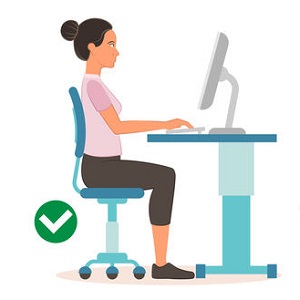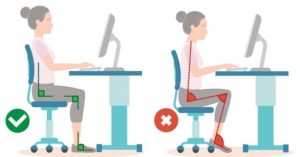Working at a computer causes foot pain
As your business develops you will probably spend more and more time in front of your computer, and you will probably develop some unexpected foot problems like swollen feet or plantar faciitis (heel and arch pain), Ensuring you’re set up with the most ergonomically designed workstation is only part of the equation. Along with the work environment, your posture, height, weight, footwear and work and exercise habits are all factors that can affect your foot health.
Feet are ‘designed’ for your mobility, not inactivity. For businesses, providing a healthy work environment includes meeting ergonomic and OH&S standards. But, whatever your work situation, especially if working from home, primary responsibility for better personal health outcomes rests with you.
Common mistakes and foot fixes when working on a Computer
Keep active
Being inactive or sitting for long periods of time is certainly something to be aware of and avoid. Inactivity can adversely affect feet, as well as your neck, back and legs. Less muscle activity means less blood and oxygen pumped back to the heart and brain and could lead to problems like swelling, even clotting (as with deep vein thrombosis on a plane). This is especially relevant if you are overweight and don’t get regular exercise. The easiest low-level fix for this is consciously getting up and walking around at least each hour.
Good footwear
Common foot problems include heel pain, sore arches, swollen feet and infected toes. These can stem from the footwear you have. Badly fitting shoes with insufficient support, unforgiving soles or the choice of fashion over function (such as high heels), can contribute to foot damage, especially if you’re working long hours. Wearing the same shoes every day or shoes made from synthetics can create the conditions for athlete’s foot and other fungal disease. If your shoes cramp your feet or toes then you can expect more of the same, as well as blisters, bunions, corns or calluses. People with flat feet or carrying extra weight can also suffer from added stress on their feet.
Posture and pain
Problems from your head, neck and back can ‘refer’ pain to your feet. Spending time hunched into a screen, with your neck forward of your spine, it can affect ligaments, muscles and nerves. Poor neck posture can lead also to degenerative spine disorders. Sciatica can be caused by any compression, irritation or damage to the sciatic nerve in the spine. The sciatic nerve attaches from the lower spine, goes down through your hips, buttocks and the back of the leg to the feet.
Leg and Foot Position
Even if you have correct upper body posture while working at your desk, how you position your legs and feet under that desk are just as important. Anything other than a natural foot posture can damage your feet by placing stress on tendons, ligaments and muscles. Wearing high heels is not natural, forcing a heels up and weight on the balls of your feet stance. This weight transfer is a bad habit, even when wearing flat heels, that could lead to your Achilles tendon being shortened and arch pain. Similarly, common foibles like legs stretched with ankles crossed, sitting on one foot, or with your weight resting on the outer side of your feet, can all lead to foot and ankle damage and pain.
Happy feet, happy business life
For an ergonomic working posture, no matter your height, your eyes should look straight ahead to the screen, your elbows should align straight to the desk and keyboard and you should sit with your back straight and legs at 90 degrees (hips level or a bit higher than knees). Your feet should be level on the floor or on a footrest. Footrests help compensate for height as well as reducing pressure on the legs through better weight distribution. In between getting up for walks, try a rocking motion to help blood flow and circulation. Then there are the daily tasks of foot care, like washing, toenail care, clean socks, or stockings.
Pain, swelling, and numbness in your feet can be symptoms of more serious issues, so see your podiatrist if pain persists.










0 Comments